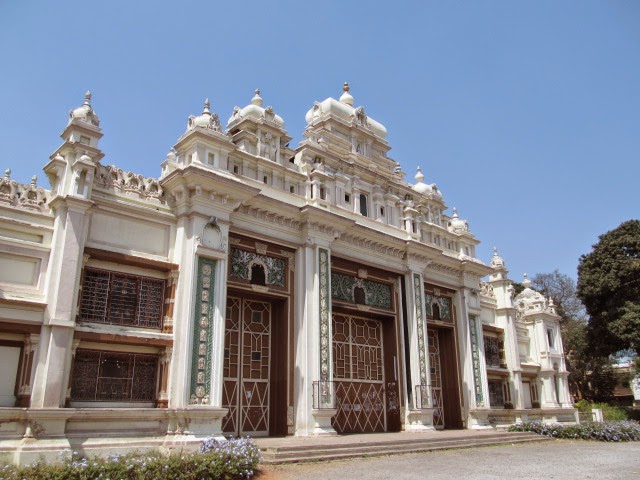Jaganmohan Palace
 |
| The Palace Gate: Jaganmohan Palace |
In Mysore, one is never too far from royalty.
Located west of the illustrious Mysore Palace, the Jaganmohan Palace is one of
the seven palaces that the Wodeyar kings built in and around the city,
making it a true recipient of the royal legacy. Within the main city itself,
there are seven such palaces. As one enters the Jayachamarajendra Art Gallery,
located inside the palace, one is greeted with a striking masterpiece adorned
with intricate carvings that have been carved in a short span of just 70 days.
Venturing deeper, one finds wooden doors that narrate the tale of Dasavatharam,
the ten incarnations of Lord Vishnu.
The Jaganmohan Palace was built during the reign of
Krishnaraja Wodeyar-III and was completed in 1861. Since the main Ambavilas
Palace, widely familiar as the Mysore Palace was burnt down in a fire, the
Jaganmohan Palace was commissioned to serve as the residence of the royal
family until 1912, the year when the Mysore Palace was completed. Many important
decisions pertaining to the erstwhile kingdom of Mysore have been taken inside
the palace premises. The coronation ceremony of Krishnaraja Wodeyar-IV took
place in a pavilion inside this palace in 1902. This was followed by the first
legislative council of the erstwhile Mysore State that was held here in July
1907 which was presided over by the Dewan.
The Jaganmohan Palace was converted into an art
gallery in 1915 and was formally renamed as the Jayachamarajendra Art Gallery
in 1955. As one walks over the cool wooden tiled floors of the palace, the
sheer number of paintings that are on display at the gallery surprise one. With
over 2000 paintings, most of which belong to different schools of Indian art. The
most common being the Mysore, Mughal and Shantiniketan style of Indian art. A
family tree of the Wodeyars since Yaduraya Wodeyar in 1399 alone captures an
entire wall. The interior walls that have been painted with murals showcase the
grandeur of the naddahabba (state festival) that is the Dasara festival and the canvas depicts
the sequence of the Jumbo Savari.
Located in three floors, the Jaganmohan Palace has some of
the finest kitsch objects, some of which are part of the royal memorabilia
which include chairs like the mayurasana, rare musical instruments and various
examples of Japanese art. There are also paintings that have been made on a
grain of rice which are visible only when peers through a magnifier. It also
has a prestigious collection of oil paintings done by Raja Ravi Varma, the
classical painter who is believed to have painted Indian Gods. Some of the
paintings narrate important scenes from the Mahabharata, Ramayana and Srimad
Bhagavatham.
Another striking feature is a painting of a 'Lady with The
Lamp' that was painted by Haldankar. It is the only exhibit which is placed in a dark room.
It gives the illusion as if the glow of the lamp lights up the face of the
woman. With a French clock which chimes as if in a parade with miniature
soldiers beating drums marking the seconds and a bugle marks the minute.
Sculptures, musical instruments, brassware, war equipment, antiques, coins and currencies
are some of the other important things one must see here. The items on display
in truly make it one of the largest collections of artifacts in South India,
making it one of the leading art galleries of the country.


Comments